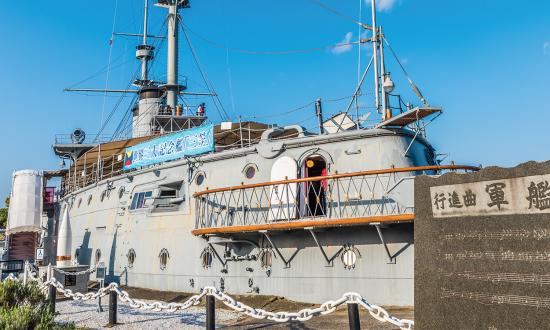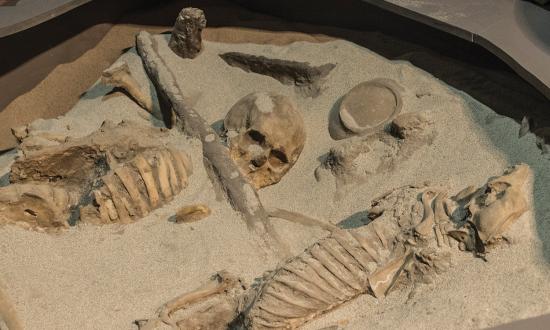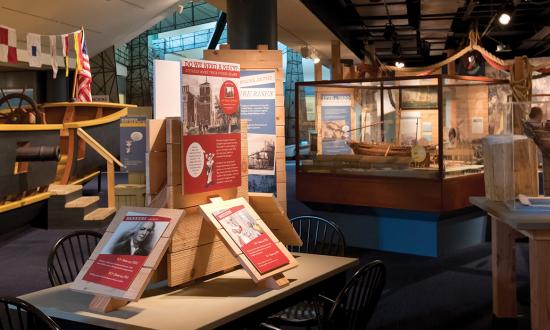In the early hours of 8 April 1942, Captain James S. Poché, master of the SS Esso Baton Rouge, entered his tanker’s charthouse to mark her position. She was about 13 miles off Brunswick, Georgia, on her unescorted voyage from Brownsville, Texas, to New York with 89,000 barrels of oil. Suddenly, the ship shuddered from an explosion on the port quarter; the unarmed tanker had been torpedoed by the submarine U-123 as part of Germany’s Operation Drumbeat (“The Drumbeat Mystery,” February 2022, pp. 12–19).
As she swiftly settled stern-first onto the bottom in seven fathoms of water, survivors abandoned ship. Rowing their lifeboats until daybreak, they set sail at dawn. Finally spotted by a patrol plane at 0700, their boats caught up with those from another tanker torpedoed by U-123 earlier that morning, Texaco’s SS Oklahoma. The little flotilla was taken in tow by a Navy patrol boat to Brunswick, and the crews of both ships were debriefed at the Coast Guard Lifeboat Station on Saint Simons Island.
Saint Simons itself was no stranger to the effects of war; it was home to the English Fort Frederica and the sites of the 1742 battles of Gully Hole Creek and Bloody Marsh between Britain and Spain during the colonial War of Jenkins’ Ear. Even in peacetime it was not immune to the consequences of distant conflict—timbers harvested from more than 2,000 Southern live oak trees on the island’s Gascoigne Bluff were used in the construction of the U.S. Navy’s original six frigates during the 1790s. It was a place shaped directly and indirectly by the shedding of blood, and in the spring of 1942, the bloody tide of war had again come to the shores of America’s home front.
At the World War II Home Front Museum, located in Saint Simon’s beautifully restored former Coast Guard station, visitors can learn about just some of the efforts that profoundly affected the area and the nation at large. Visitors to the museum enter through the station’s former boathouse and are immediately greeted by a huge map of the locations featured in the museum—the station itself, Naval Air Stations (NASs) Glynco and Saint Simons, the Naval Radar Training School (NRTS) at the requisitioned King and Prince Hotel, the Brunswick shipyards, and the sites of the torpedoing of the Esso Baton Rouge and Oklahoma—after which they are treated to a timeline and film outlining the buildup to the war.
The hallway beyond gives an excellent overview of the efforts required to mobilize for war—rationing, civil defense, Selective Service, and the significant contributions of black Americans to the war effort. Interactive exhibits allow visitors to test their mettle identifying friend from foe when plane spotting (a key duty of citizen coastwatchers during the war) and selecting personal criteria to see how one could have participated in the war effort.
After exiting the boathouse, visitors can enter up the stairs of the old lifeboat station itself and dive into the history of the locations noted on the map at the entrance. A large pictorial exhibit draws on the history of the station itself and related activities, from the training of 3,000 dogs for the Coast Guard to the impressment of civilian boats into the Georgia State Guard to support shore patrols. An interactive exhibit allows visitors to practice knot tying and Morse code.
NAS Glynco takes center stage in an adjoining room. North of Brunswick, the wartime naval air station and its pair of massive wooden hangars housed Airship Patrol Squadron 15 (VP-15) and its fleet of eight K-class nonrigid airships. The blimps’ central role in maritime patrol and convoy escort is highlighted, as well as Navy WAVE photographers who documented the activities at Glynco.
The next room highlights NAS Saint Simons and the NRTS and their roles training men for the fight. Large displays explain what radar is, how it works, and how the then-nascent technology was used. An interactive exhibit made from period Navy hand-crank telephones provides narrated firsthand accounts of the NRTS and how aviators from NAS Saint Simons flew simulations for the school.
Another display concerns the shipyards outside Brunswick of the J. A. Jones Construction Company, which built dozens of Liberty ships for the U.S. Maritime Commission, U.S. Army, and the British Ministry of War (through Lend-Lease), and the Brunswick Marine Construction Corporation, which built smaller tugs, fleet oilers, and freight and supply ships during the war. Visitors can view an array of tools and other artifacts used in shipbuilding, as well as a very detailed model explaining the construction of a Liberty ship.
One of the most poignant exhibits shows several artifacts from the Esso Baton Rouge, including a life ring and the ship’s bell, which Captain Poché gave to the owner of a local cruising yacht who assisted in salvage efforts. Both tankers torpedoed that February would be successfully refloated under the watchful eyes of a Royal Canadian Navy corvette and a blimp out of NAS Glynco—though both again would be sunk later in the war. A more somber note is found outside the museum on a historical marker, which relates how five seamen killed in the April 1942 torpedo attacks, unidentified at the time, were laid to rest in nearby Brunswick. A memorial to all 22 sailors killed in the attacks stands outside the Glynn County Courthouse in Brunswick.
The shipyards are now long gone; the King and Prince is a hotel once again, and both former naval air stations now serve private jets. But the legacy and impact of the war live on at the World War II Home Front Museum. The most fortunate museum visitors, though, may get to hear the recollections of storytellers at the museum who share their memories of the war years, both on the home front and abroad.
Located adjacent to the aptly named Coast Guard Station Beach, visitors to the museum easily can spend a day enjoying the surf and sand, and the museum is minutes from the National Historical Sites and Monuments at Frederica, Bloody Marsh, and Gully Hole Creek and the historic Saint Simons Lighthouse Museum, as well as golfing and other amenities for which the island is well known today. Any visit to the area, though, would be incomplete without stopping by this gem.









